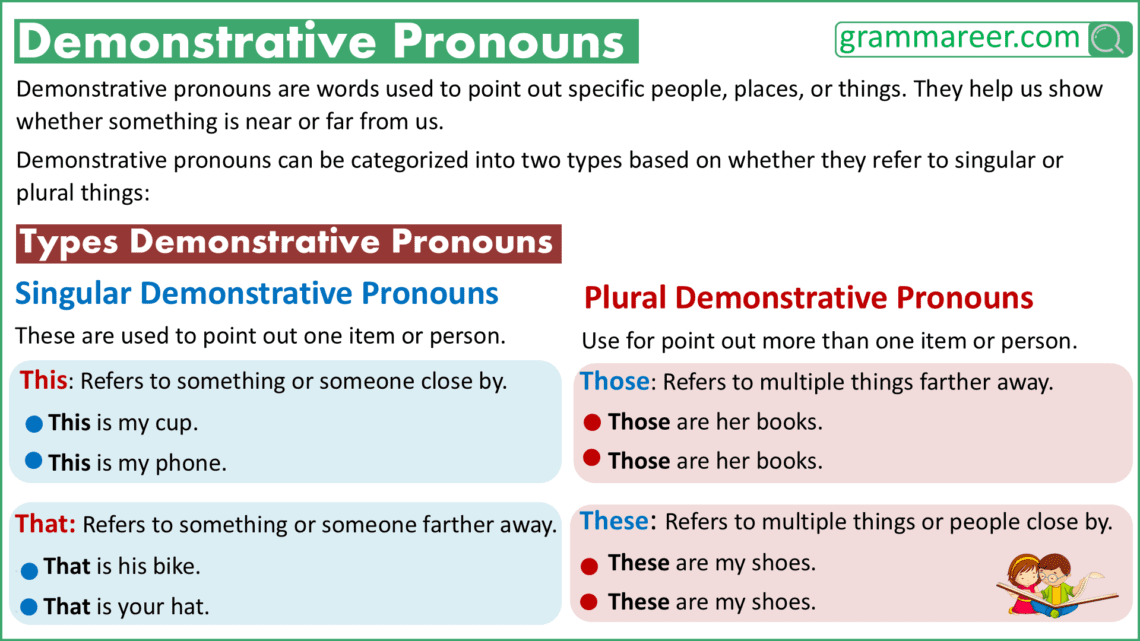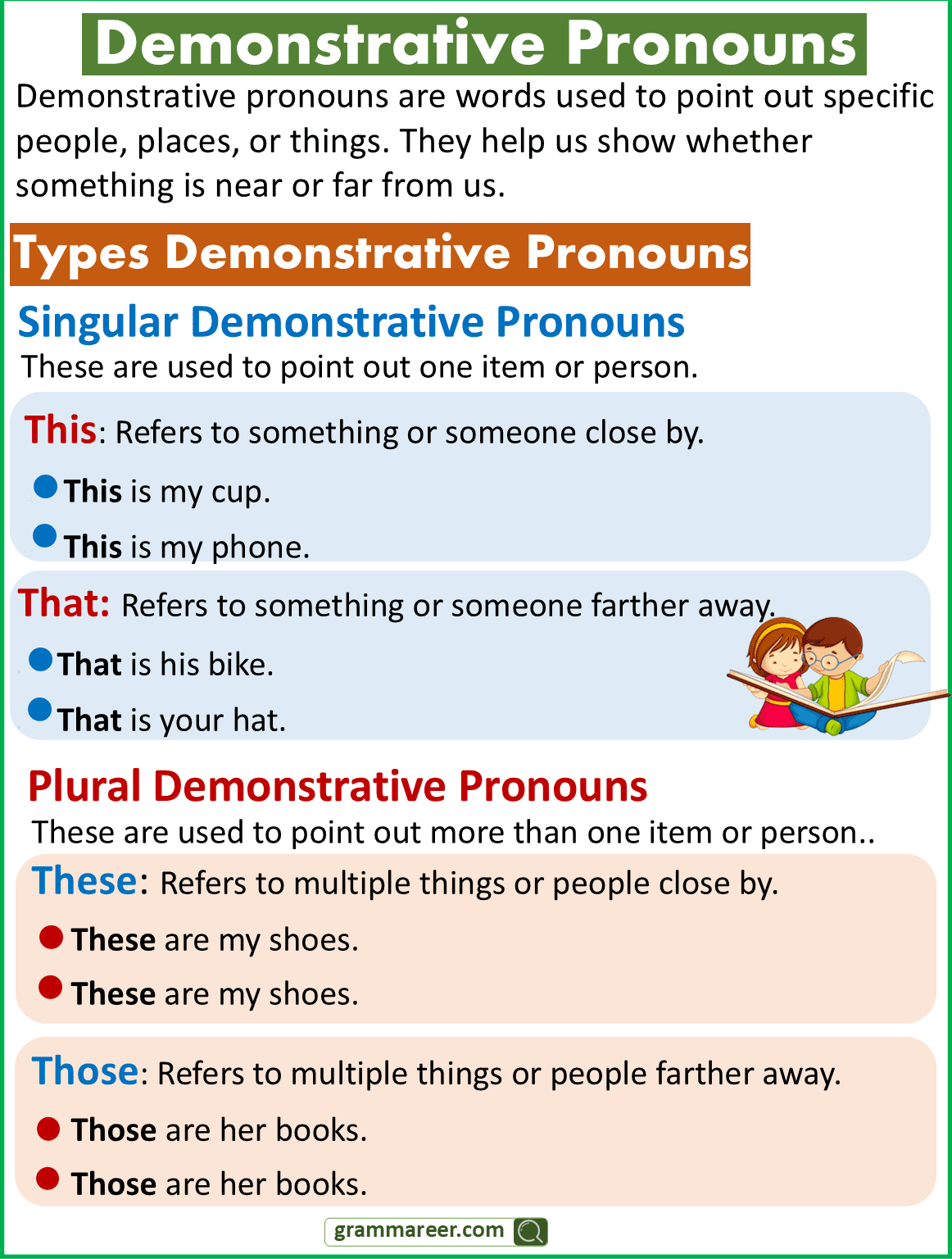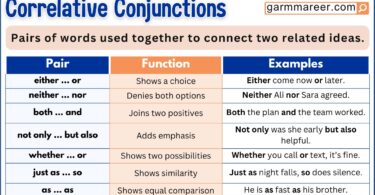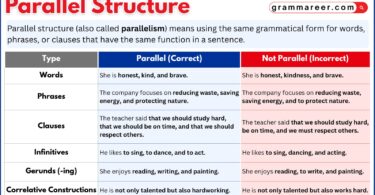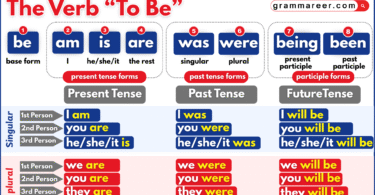In English grammar, demonstrative pronouns are pronouns that are used to point out and identify a specific noun or group of nouns. They replace the noun they refer to and help indicate its location or proximity to the speaker.
Table of Contents
Definition
Demonstrative pronouns are pronouns that are used to point out and identify a specific noun or group of nouns. They replace the noun they refer to and help indicate its location or proximity to the speaker. There are four primary demonstrative pronouns in English:
- This
- That
- These
- Those
Types of Demonstrative Pronouns
Demonstrative pronouns can be categorized into types based on their singular or plural usage, as well as their proximity to the speaker.
Singular Demonstrative Pronouns
Singular demonstrative pronouns are words we use to talk about one specific thing. There are two main singular demonstrative pronouns:
This – used when we want to talk about something that is close to us.
- This is my favorite hat.
- This is the book I was reading.
That – used when we want to talk about something that is farther away from us.
- That is a beautiful painting.
- That was an exciting movie.
Plural Demonstrative Pronouns
Plural demonstrative pronouns are words we use to talk about more than one thing. There are two main plural demonstrative pronouns:
These – used when we want to talk about multiple things that are close to us.
- These cookies are delicious.
- These are my best friends.
Those – used when we want to talk about multiple things that are farther away from us.
- Those are the flowers I picked.
- Those are the books I borrowed from the library.
Examples
- This is my favorite sweater.
- That was an interesting movie.
- These are the books I borrowed from the library.
- Those were the best cookies I’ve ever had.
- This is the place I was talking about.
- That is the house where I grew up.
- These are my new shoes.
- Those are my friends standing over there.
- This is the best decision I’ve made.
- That was a long day at work.
Function and Usage of Demonstrative Pronouns
Demonstrative pronouns are unique because they replace specific nouns that the listener or reader already knows about. This makes them useful in conversations or writing where the noun has already been mentioned, or when the noun is visible or known to both the speaker and the listener.
Pointing to Objects in Physical Space
They can be used to refer to things that are physically present or visible.
- This is my chair, and that is yours.
(Here, the speaker is pointing to specific chairs.)
Referring to Time
Demonstrative pronouns are also used to refer to time, especially when discussing past, present, or future events.
- This is the moment we’ve been waiting for.
(Present time, happening now.) - That was a memorable day.
(Referring to a past event.)
Avoiding Repetition
They are very useful for avoiding unnecessary repetition of nouns, which can make sentences more concise and clear.
- I bought a new car. This is much better than my old one.
(Instead of repeating “the car,” the pronoun “this” refers to it.)
Demonstrative Pronouns vs Demonstrative Adjectives
| Aspect | Demonstrative Pronouns | Demonstrative Adjectives |
|---|---|---|
| Definition | Words that replace nouns and stand alone. | Words that modify or describe nouns. |
| Function | Used to point out specific things. | Used to specify which noun is being referred to. |
| Examples | This, that, these, those. | This (book), that (car), these (apples), those (houses). |
| Position in a Sentence | Usually stands alone (e.g., This is mine). | Comes before a noun (e.g., This book is mine). |
| Usage | Replaces a noun in a sentence. | Describes a noun in a sentence. |
| Referencing | Can refer to people, places, or things. | Must always be followed by a noun. |
Common Mistakes to Avoid
Although demonstrative pronouns are simple, they can lead to confusion if misused. Here are some common mistakes to avoid:
Overuse or Repetition:
- Incorrect: This this is mine.
(Here, it is used twice, which is unnecessary.) - Correct: This is mine.
Ambiguity:
- When using them, make sure the reference is clear.
- Incorrect: Take that.
(It’s unclear what “that” refers to. The context should be clear to avoid confusion.) - Correct: Take that book from the table.
Read More

